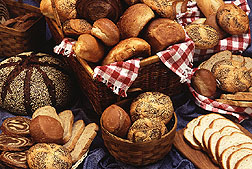This page has been archived and is being provided for reference purposes only. The page is no longer being updated, and therefore, links on the page may be invalid.
Low-Phytate Wheats: How Do They Bake?
By Don ComisDecember 28, 2006
Newly developed lines of wheat with one-third less phytate than current varieties—and up to three times more phosphorus in the flour made from the wheat—are being developed by breeders. They promise to offer better nutrition, both as feed for livestock and in breads and other wheat-based foods for people.
Agricultural Research Service (ARS) plant geneticist Edward J. Souza and colleagues at the University of Idaho Research and Extension Center in Aberdeen—Mary J. Guitteri and Karen M. Peterson—conducted a rare study on the effects of low-phytate wheat lines on baking qualities of the flour made from them. They found there to be no adverse impact on hard wheat, but some ill effects on soft wheat lines.
Phytate contains phosphorus in a less-digestible form, which leads to less nutrition for people and animals and much more polluting phosphorus excretions from livestock. Low phytate levels help people absorb not only more phosphorus, but also zinc, manganese and iron from whole-grain products, thus increasing their nutritional benefits. These and other minerals are naturally present in wheat kernels.
The ARS-University of Idaho study showed that low-phytate hard wheats might have better dough-mixing qualities for breadmaking. However, the scientists will need to do further tests to confirm the effects of low phytate on soft wheat, which appeared to increase the flour's ability to absorb water. The scientists did their tests on two classes of hard wheat and a premium class of soft wheat.
Souza, formerly at the University of Idaho, is now research leader at the ARS Soft Wheat Quality Research Unit at Wooster, Ohio. Guitteri is now at the Ohio Agricultural Research and Development Center at Wooster.
The scientists also tested the agronomic performance of the low-phytate wheats grown for two seasons in field studies at Aberdeen and Tetonia, Idaho. The lines sometimes had lower yields and smaller kernels. The inconsistent yields suggested the problem was minor, with enough genetic variation to solve through plant breeding.
Four papers by the scientists on various aspects of low-phytate grains appear in the November-December 2006 issue of Crop Science.
ARS is the U.S. Department of Agriculture's chief scientific research agency.

